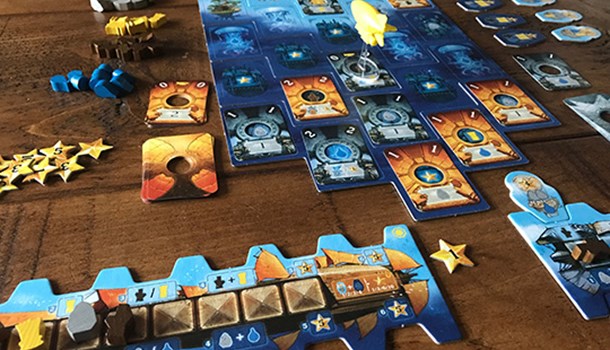
Written by Bryony Stibbons on 21 Feb 2019
Distributor Asmodee • Price £43
Players: 1-4
Game Length: 30-40mins
Theme
‘For several millennia, the tiny planet Solenia has lost its day-and-night cycle: Its northern hemisphere is forever plunged into darkness and its southern hemisphere is eternally bathed in sunlight.’
As you play this game you are challenged with collecting much needed resources that are scarce on the opposite hemisphere and deliver them to the cities that need them. The larger the size of the delivery, the greater the reward.
Set Up
A short amount of set-up is required taking about 10 minutes:
Game Play
Players take turns to reveal their top ‘window’ card, which shows on it a number from zero to two. They then need to place this card onto one of the islands on the board sticking to the rule that it must be either adjacent to the airship or to another of their previously placed cards.
Placing the card on an island with a resource (you will see the resource through the porthole) will get you the number of that resource dictated by the number on the card – sadly sometimes this is zero. If you play your card onto a city (meaning a star is visible through the porthole) you instead get the corresponding number of stars (these serve as victory points at the end of the game) but at this point you also need to make a delivery – select one of the delivery cards that you can fulfil, give up the resources and claim the delivery tile. Inserting that tile in your ship will earn you an instant bonus and at the end of the game you will get the number of victory points on it, as well as bonus points for the number of pairs of day and night deliveries you achieve.
Playing a zero-value card will cause the airship to move forward one space and at this point the bottom section of the game board is removed, flipped over and moved to the opposite end (meaning that the airship is always in the central spot). At this point any cards sat on the removed section will earn the owner rewards – indicated by a picture at the bottom – usually in the form of extra resources, but sometimes stars.
The game ends when each player has played all 16 of their cards and at this point all victory points and bonus’ are added up to find the winner.
There are two additional developments to the game;
The Verdict
I hope my quick attempt at describing how this game plays does it justice, as it is totally unique and I really enjoyed it! The concept of collecting resources and spending them to gain rewards is not a new one in the world of boardgames, but the completely unique element is the way that the board is constantly rotating throughout the game and you really have to learn to use this to your advantage.
Tactically there are two different paths you can go down – either trying to complete the highest points value deliveries, or complete more low points deliveries in order to earn more bonus points for achieving pairs. I thought I was well ahead in the first game I played because I had completed lots of deliveries, only to find that I lost by one point because my opponent, who had only completed a few deliveries, had done all the top value ones.
The game is really well designed, illustrated and put together, right down to the way that the box is designed with special dividers to help store all the pieces. Plus, there are only three pages of rules to go through to learn it, with a further one for the solo and winter modes. This is partly thanks to the fact that the rules are put together concisely with great pictorial examples, completely free from the waffle you often get.
The winter mode adds additional elements and makes, what is a fairly straight-forward game, more appealing for hard-core games like me who love complexity. However, the solo mode was a little disappointing as it didn’t really challenge me with it not being a win/lose scenario. Also, the die dynamic used to dictate the opponents moves doesn’t provide an adequate substitute for a two or more player game. That’s not to say it was terrible. As I loved the game overall and do sometimes like to play games alone, it worked well enough to give it another go some time.
The two-player game was great fun, but increasing to three of four players made it even more interesting as there are more board rotations, giving additional bonus resources as cards are eliminated from the play area and allowing you to complete more deliveries – I would say 3 players is the optimum.
Overall, I though it was a brilliant game, bringing a concept that I haven’t come across before. It is simple enough that you can get going quickly and easily teach others, but complex enough that it is tactically testing and this is always the best combination. I also love that the game isn’t hiding behind an extravagant concept, gimmick or branding – it is a great game based on game-play alone. I would highly recommend Solenia to anyone who enjoys games like Settlers of Catan, but its suitable for all levels of gamer (including kids aged 10+).

A life-long board game addict, but anime newbie, Bryony is gradually getting hooked!
by Bryony Stibbons on 04 Aug 2019
by Bryony Stibbons on 19 Jun 2019
by Bryony Stibbons on 08 May 2019
by Bryony Stibbons on 02 Feb 2019
by Bryony Stibbons on 09 Jan 2019
by Bryony Stibbons on 17 Dec 2018
by Bryony Stibbons on 08 Dec 2018
by Bryony Stibbons on 14 Nov 2018